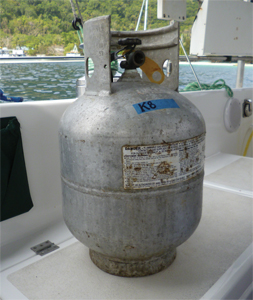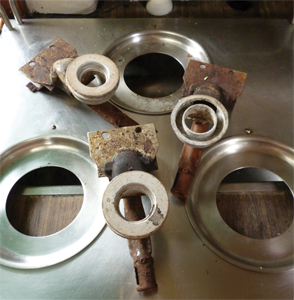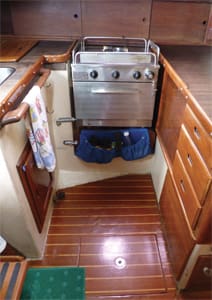It has been said that next to the mast, the stove is the most used piece of equipment on board, and on my boat this is certainly true. Having a stove that functions well — under all conditions — is of the utmost importance. Regardless of the kind of boat you own or stove you use, it must be safe and efficient, especially when used offshore.
Types of stoves
These days most modern sailboats come standard with a liquefied petroleum gas (LPG) stove and oven combo. Both propane and butane are LPG fuels. Most stove installations that burn LPG use propane rather than butane fuel. The second most popular option of cooking is an alcohol-burning stove. There is a long-standing debate among sailors about the safety and merits of both types of fuel, with the pros and cons of each side staunchly defended.
The main argument against carrying LPG is that both propane and butane are heavier than air. Storage lockers must be properly vented so that any escaping gases do not make their way into the bilge where a spark could cause a lethal explosion. Most modern stoves come standard with a failsafe: a temperature-sensitive thermocouple that will stop the flow of gas within a few seconds of the flame being blown out. As an extra precaution, systems should also be properly fitted with an electric solenoid. This allows for the user to manually shut off the gas without accessing the tank should a problem occur between the tank and the burner.
Both pressurized and non-pressurized alcohol stoves use denatured alcohol (ethanol that has been mixed with a small amount of methanol and often a few other trace additives) for fuel. Manually pressurized alcohol stoves have a reputation for dangerous flare-ups when lighting, though there are some tricks to make the process safer. Opponents of alcohol argue that the clean-burning flames are hard to see and spills can often ignite without notice. People will complain that alcohol does not burn as hot as LPG; this is actually true, but the sailors I spoke to who use alcohol reported that the cooking times are not dramatically increased, certainly not enough to deter them from using alcohol on board.
Like so many other pieces of equipment, alcohol stoves have improved in design and safety over the years. Popular contemporary brands are no longer hard to fill, another common complaint among users. Non-pressurized alcohol stoves use metal canisters fitted with non-flammable wool filler. This material soaks up the alcohol and releases alcohol vapor in a controlled manner.
There are a small number of boats that use kerosene stoves, but their popularity is dwindling. Diesel stoves are well liked among high-latitude explorers, both for heat and for cooking. Having a diesel stove means they only have to bunker one fuel source, and in such cold remote destinations it is probably one of the easiest fuels to find.
Long-range powerboats have the option of electric galley appliances, often a flat ceramic or induction cooktop and a cabinet-mounted oven. Recent models have built-in safety devices that automatically turn burners off when a pot is removed, and have audible warnings when items are placed on the cooktop when not in use. Since motor vessels spend a lot of their time with engines running or are outfitted with generators, the power consumption of electric equipment is not of the same concern as it is on a small sailboat.
 |
|
An aluminum tank for storing liquefied petroleum gas (LPG). |
|
Heather Francis |
The galley underway
Sometimes it feels like cooking underway requires four hands: two to deal with the meal and two more to keep stable and upright. The standard “U-shaped” galley on a sailboat was designed to be practical, but not necessarily spacious. Everything is within arm’s reach and there are lots of places to hold onto or brace yourself against, making it a comfortable space to work in. That said, designers are not always users so if you are constantly reaching for a handhold that is not there, install one. Mine doubles as a place to hang a tea towel.
On a sailboat, a gimballed stove with well-fitting rails and fiddles is your best friend when it comes to cooking underway. Stoves should be gimballed athwartships — not fore and aft — allowing the unit to swing as the boat heels, keeping the cooking surface level. Fiddles, or pot restraints, keep pots securely over the burners while cooking and a high rail on all four sides will stop pots from falling to the floor if the boat rolls unexpectedly. And a lock on the oven door will make all the difference if you plan on baking or roasting meals underway.
If you have a new model boat or stove these things come standard. But, if you are like me and have purchased a boat with an older stove, you might have to think outside the pot, so to speak, to make the stove a safer place to be underway. I’ve scrounged fiddles from abandoned stoves in boatyards until I found a mismatched set that was up to the task. We installed a simple sliding bolt lock to the oven door and modified the railings so that pans could not slip under them. These changes have made a tremendous difference; I can now momentarily step away from the stove without worrying about getting injured when a pot slips off the burner or scalding hot food goes airborne. Invest the time and, if necessary, money to make your stove a functioning piece of equipment at sea. It will make cooking easier and safer.
Powerboats do not travel on a constant heel and often have the benefit of stabilizers, so the galley layout can be more spacious and stoves do not have to be gimballed. Grab rails come in handy when the boat encounters rough conditions, however, and rails and fiddles are still necessary to keep pots from sliding around flush electric burners.
Whenever working down below, stand with your feet wide; this will give you better balance and stability. Make sure there is a stable handhold near the stove so that you do not accidentally grab the stove when thrown off balance. Choosing a pot that has a tight-fitting lid and is slightly larger than needed will make sure hot food and liquids have adequate space to slosh around as the boat moves. And if conditions deteriorate so standing near the stove feels too dangerous, try easing the motion of the boat by altering course or heaving to while cooking.
Some people like to use a galley belt, a type of harness that is worn around the back and tethered to a fixed point near the stove. These can give you hands-free stability and prevent an accidental fall but they can also be dangerous. Tethering yourself close to the hot working area means that if a scalding liquid spills or a pot jumps off the burner you may not be able to move out of the way. When sailing offshore where medical help is often several days away, injuries are not only an inconvenience they can quickly become life-threatening.
Safety first
If you are using LPG, it is preferable to carry aluminium or certified fiberglass tanks. Household steel tanks are prone to corrosion when exposed to salty environments, and trouble spots can often be hidden under paint. Be aware that some countries like Australia and New Zealand will not fill fiberglass tanks purchased overseas.
 |
|
Old corroded LPG burners like these should be replaced. |
|
Heather Francis |
Some LPG tank valves have both internal and external threads, making filling anywhere in the world possible. If your tank does not come standard with both, consider buying an adapter. Not only will you be able to get a fill no matter how small or remote the filling station, but it will ensure that the threads are not damaged by someone jury-rigging a fill setup.
Alcohol, kerosene and all other stove fuels should be stored well away from the stove in certified storage containers. In case of an accidental fire, this eliminates combustibles in the area that could feed the blaze.
General safety checks should be a part of the regular routine on board and the galley is no exception. Inspect gas hoses that run through compartments and behind the stove for signs of chafe every couple of months. This is especially important if the unit is gimballed and used underway often. Any new installations, alterations or repairs to existing systems should always be done by a reputable gas fitter.
Install fire extinguishers in an easy-to-reach place in or near the galley. Service them regularly and, most importantly, make sure everyone on board is familiar with how to use them. Powerboats or larger sailboats could consider installing a fixed firefighting system if they have an exhaust hood fitted over the range, and a fire blanket is an inexpensive but extremely effective way to douse accidental flare-ups.
No matter where you go or how you voyage, the crew will always need to be fed. The galley on any vessel should be a secure and practical place to prepare meals and the stove deserves a little special consideration. Investing a little time and attention into your galley setup and equipment will not only ensure everything performs and lasts for many years, but will keep the cook safe whether at anchor or offshore.
Heather Francis is originally from Nova Scotia, Canada. For over a decade she traveled the world living and working on boats. She has cooked professionally on land and on private yachts. Now you’ll find her in the galley of Kate, the Newport 41 she and her Aussie partner Steve are slowly sailing around the world. Follow their adventures at www.yachtkate.com.

